by Robert Craig with updates by Cappy Stults.
While giving historical walking and bus tours around town, many questions are asked and a couple deserve some special attention. One is “what was where Perritt Labs is today before it was the post office” and another is “where did Bank Street gets its name? From the banks of the Rocky Brook?”
The first question will be answered by reprinting an article written by a much younger Bob Craig back in April 1981 for a periodical called The Princeton Recollector. It was entitled “Baptists Alarmed to Find New Neighbors were Universalists”. Bob has given me permission to downsize and update the article since it was written in 1981 terms.
Universalist Church: South Main Street
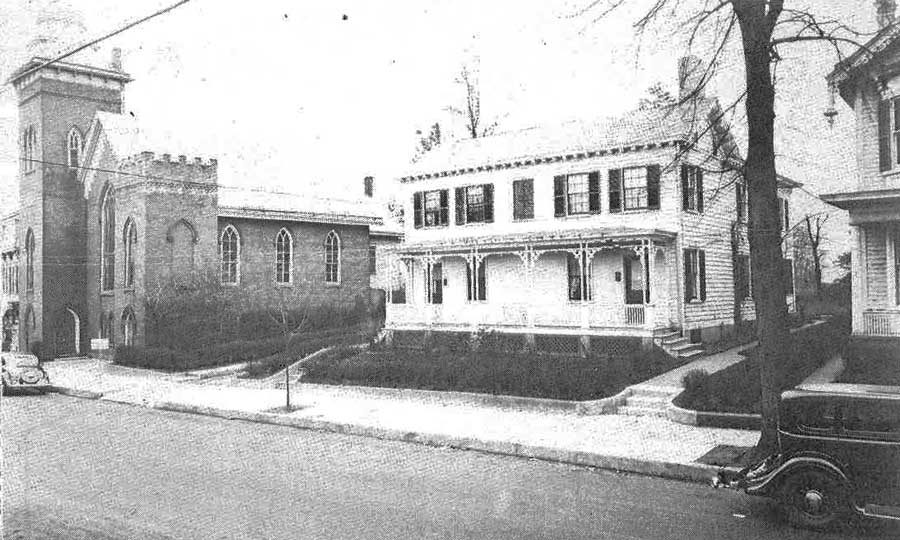
Both the church and the adjacent two family house were torn down for the post office in 1936. You can sort of make out the Baptist Church behind the Universalist Church.”
One of the important institutions in Hightstown a hundred and fifty years ago was the Universalist Church. The church stood on the East side of South Main Street, where the driveway of the old Post Office is today, now Perritt Labs. The Universalists church closed for good in 1918, and it was demolished in 1935. Few living today will remember the congregation or church building. It is unlikely that there are any surviving members of the congregation.
In the years 1970-1980, many of the papers of Joseph J. Ely, a Universalist, came to light and shortly thereafter, the Hightstown East Windsor Historical Society had acquired a thick file of correspondence concerning the church. In the 1870s, Hightstown was one of the only towns in New Jersey with a flourishing Universalist church, for Universalism tended to thrive in the big cities and in New England. The tenets of the faith were the universal fatherhood of God, the spiritual leadership of Christ, and the inevitability of the just retribution for sin, with this central doctrine being the ultimate salvations of all human beings. To commemorate the sect’s hundredth anniversary in 1870, two years later Reverend Abel C. Thomas published, A Century of Universalism. “Universalism”, he said, “is both the Heart and the Head of Christianity. The final reconciliation of our souls is the distinctive thought of our profession and faith, and we cannot cancel or suspend that, for the accommodation of any unbeliever.”
Thomas devoted a whole chapter of his book to the Hightstown Universalist church. The Hightstown church first organized informally in the 1820s among a cluster of farm families which included the Johneses and the Nortons, who lived in East Windsor near Perrineville and Cedarville Roads. Around 1828 they built a schoolhouse , which became the Cedar Grove School (aka Cedar Swamp). It stood on the easterly side of Cedarville Road on the farm of Samuel C. Johnes. However, a majority of the township voters, who were members of the Baptist and Presbyterian churches, persuaded the township committee to prohibit the use of the schoolhouse for Sunday worship services. This ordinance was strictly enforced, so the Universalists had to meet elsewhere.
In 1834, the Baptists put their old meeting house up for sale (immediately south of the current Baptist church’s building known as the Livingston Home). The Baptists had built it in 1785, when they first moved to Hightstown. The buyer was Charles D. McChesney, a Universalist. The Baptists thought he was going to use the structure as a barn; instead, two or three weeks later, he sold it to the Universalist congregation, which renovated it and refurbished it as their church, only two doors away from the new Baptist church. The Universalists held their inaugural service in their new place of worship on August 10, 1835, and Rev. La Fevre, their first minister, delivered a sermon from Haggai II:9: “The glory of this latter house shall be greater than of the former…” Understandably, the Baptist must have felt insulted by this state of affairs.
The Universalists exerted an influence on the town beyond what their number would suggest. Universalism had widespread appeal among intelligent people, and in the Hightstown church were many of the town’s reformers and well-educated residents. In contrast to the Baptist congregation, which some considered a “country church”, since mainly farm families belonged, most of the Universalists lived or worked in town. Dr. McChesney, one of the town’s earliest practicing physicians, served as New Jersey Secretary of State from 1840-1851, and became an important collector of Revolutionary War manuscripts. Charles C. Blauvelt and Joseph Blauvelt, father and son, both served as mayor of Hightstown Borough. Joseph J. Ely, who lived in Millstone, but included Hightstown in his law practice, was, at about the time of the Civil War, the leader of a movement to make Hightstown the seat of a new county to be called, “County of Stockton”. He was also active in the temperance movement, and published many pamphlets on Universalism and various reform subjects. Mary Norton, the best known Universalist of Hightstown, was active in Civil War relief work. Her friendship with Clara Barton and her invitation to teach at the Cedar Grove School are what brought Barton to East Windsor.
For several decades the church prospered. In 1871, the congregation had the old sanctuary demolished and a new, larger one erected, celebrating its completion with ceremonies attended by Horace Greeley and P.T. Barnum. Mary Norton and Mary Kay Peppler bequeathed large sums which helped endow the church for operating expenses, and more land was bought. A parsonage also stood on the church property. It became debt free in 1911.
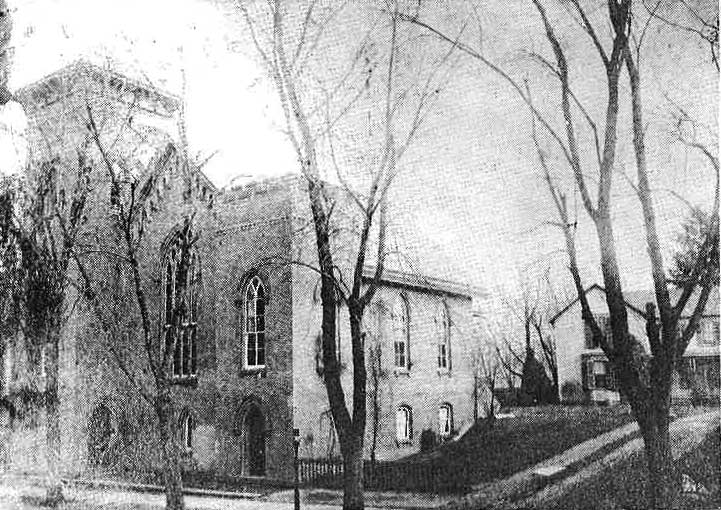
The church manse was in the rear as seen on the right. It was demolished along with the church in 1936.
At its height around 1900, the congregation of the Hightstown Universalist church included about three hundred people, or about two hundred families. Mr. and Mrs. Harvey Rue belonged, as did the William Thompson family. Will Jr. was an owner of the rug mill, while his brother, Ernest owned a drug store. The Brearly family belonged, and Abijah Applegate and Albert Conover. Mrs. Walter C. Black (nee Shinn), and her three daughters were members, (one married a Locke whose son Joseph took over Village Nurseries, and another daughter married C. Stanley Stults). It is said that Mr. Black, for whom one of the elementary schools is named (that would be Walter C. Black), seldom, if ever, attended services. George and Joseph Shinn were members, as was Kenneth Ward, whose family at one time owned all of the land where Peddie School now stands.
After 1910, the church fell on hard times. Reverend Ashworth, who had made the church debt free, left in 1911, and with him went much of the glue that held the congregation. The church closed in 1918. It was intended to open again. Members drifted to other congregations (Nettie Black Stults and sister Elma Black Locke became Baptists).
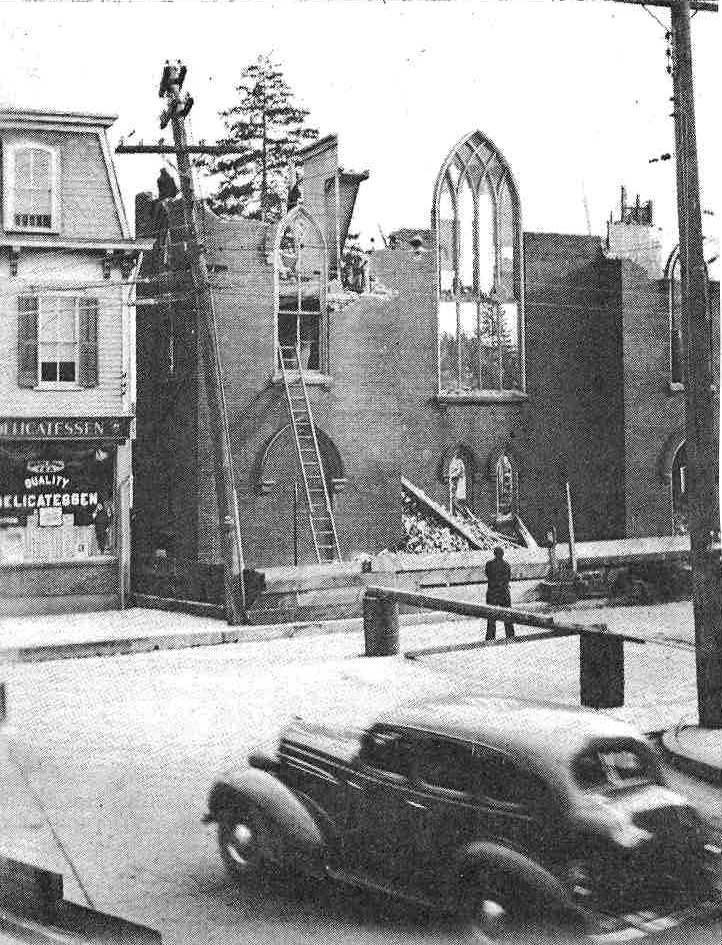
The demolition. The building on the left still remains and is owned by the Baptist Church. It one was the Allen & Stults Funeral Parlor.”
After many failures to reopen the church, efforts were made to adapt the church building for other purposes. The town’s bicentennial had sparked the creation of a public library, and a suggestion was offered to use the Universalist church. The legal owner was the Universalist General Convention, the offices of which were in Boston. It took many years to straighten out the boundaries and title issues, during which time the Masons and Grange continually tried to get permission to occupy it. Some other congregations wanted to use or purchase it and then in November 1935, it was announced that a new post office would be erected on the site. After that, attention shifted to salvaging what could be removed, such as pews, hymnals and prayer books. The pulpit furniture, the church records, and a bench from the original Universalist church were taken to Murray Grove, now Lanoka Harbor. The church, parsonage and another house just south of the church were demolished for the new post office.
Trinity Episcopal Church: North Main & Bank Streets
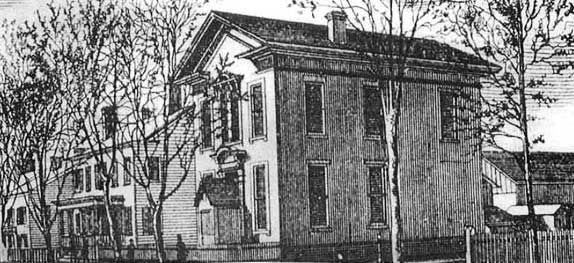
Pencil sketch from the 1860s. The house to the left is Ely House, aka the Historical Society Headquarters.
The Protestant Episcopal Church had its first services in Hightstown in 1847 and it was formally admitted into the union of the diocese in 1859. For a number of years the church tried to find a suitable lot to build on but to no avail. Then, in 1875, the Central Bank of New Jersey, which was on the corner of Bank and North Main Street, relocated to a building in the center of Hightstown. The bank’s President was R.E. Morrison and its cashier, T. Appleget. This bank later had some scandals which will be a subject of a future article. I am in possession of what I believe was one of the bank’s last minute books.
The church was able to purchase the bank building for $2,025 in 1875 and in 1881 the church was virtually debt free. Its approximately one hundred and forty members were able to attend services without having to pay “pew rent”, which was a norm of the times. The church was stable for many years and had support of Trinity Church in Princeton. Also many Peddie boys attended services and even had formed a choir. Peddie had bought the Lantz Hotel for a boy’s dormitory. It was where the fire house is now located, nearly adjacent to Trinity Church.
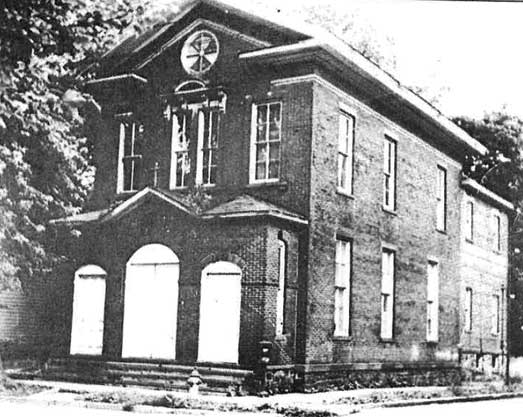
Trinty Church after the church was closed down
Unfortunately its congregation waned in the early 1950s for reasons unknown. Peddie had hired its own Episcopalian chaplain who cared for the boys spiritual needs on campus in its relatively new Ayer Chapel that had been build in 1949. Maybe this was one of the contributing factors. The church held its last service in 1956. The Borough of Hightstown condemned and purchased the lot and building for $100 in 1958. It was demolished in 1959. Now you know why the street is called “Bank Street” and not “Church Street”. The historical society is the current owner of the lot having bought it in 1990 from the borough in order to accommodate the move of the freight station.
Support local history like this by becoming a member here.
